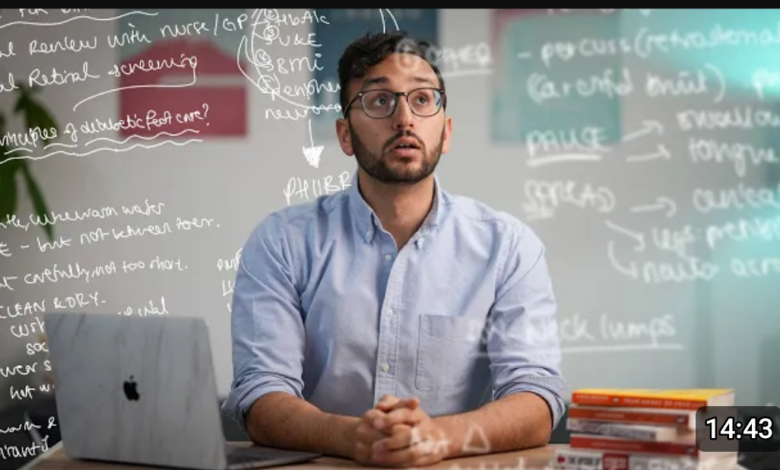HOW TO LEAND ANY SKILL IN THE WORLD BY USING CHATGPT
Do you want Lean different skills in the world?

Learning any skill in the world through ChatGPT is possible by following these steps:
- Define Your Learning Goal: Clearly identify the skill you want to learn. Be specific about what you want to achieve and the level of proficiency you aim to reach.
- Research and Gather Resources: Utilize ChatGPT to gather information and resources related to the skill you want to learn. Ask for recommended books, online courses, tutorials, video resources, or any other relevant materials.
- Create a Learning Plan: Develop a structured learning plan with clear objectives and milestones. Break down the skill into smaller sub-skills or topics to make the learning process more manageable. ChatGPT can help you organize and prioritize the content you gathered.
- Ask for Guidance and Clarification: Whenever you encounter challenges or need further clarification, don’t hesitate to ask ChatGPT for assistance. It can provide explanations, examples, and additional resources to deepen your understanding.
- Practice Regularly: Learning a skill requires consistent practice. Engage in practical exercises, apply the knowledge you acquire, and seek feedback from ChatGPT on your progress. It can provide insights on how to improve and suggest relevant practice activities.
- Seek Feedback and Evaluation: ChatGPT can provide feedback on your performance and help you evaluate your progress. Share your work, ask for assessments, or discuss your learning outcomes with ChatGPT to gain valuable insights and identify areas for improvement.
- Join Online Communities: Participate in online forums, social media groups, or communities related to the skill you’re learning. Interact with others who share similar interests and learn from their experiences. ChatGPT can suggest relevant communities for you to join.
- Embrace Challenges and Failure: Learning a new skill involves overcoming challenges and making mistakes. Embrace these experiences as opportunities for growth. ChatGPT can offer encouragement, guidance, and strategies for overcoming obstacles and staying motivated.
- Adapt and Update Your Learning Plan: As you progress and gain more knowledge, update your learning plan accordingly. ChatGPT can assist you in refining your plan, suggesting advanced topics, or providing insights on specialized areas within the skill you’re learning.
- Stay Curious and Never Stop Learning: Learning is a lifelong journey. Cultivate curiosity and continuously seek new knowledge and updates in your chosen skill. ChatGPT can recommend additional resources, learning paths, or related skills to expand your expertise.
Remember, while ChatGPT can provide valuable guidance and resources, actively engaging with the materials, practicing regularly, and seeking practical experiences outside of the chatbot interaction are essential for effective skill development.
Defining your learning goal is a crucial first step in the learning process. By clearly identifying the skill you want to learn, you can set a specific target and work towards achieving it. Here’s how you can define your learning goal effectively:
- Choose a Specific Skill: Determine the particular skill you want to acquire. For example, if you want to learn programming, specify the programming language or framework you wish to focus on, such as Python or JavaScript.
- Determine the Scope: Define the scope of your learning goal. Consider whether you want to learn the basics of the skill, gain intermediate proficiency, or become an expert in the field. Setting a clear level of proficiency helps you structure your learning journey.
- Outline Your Objectives: Break down your learning goal into smaller, manageable objectives. These can be specific tasks, sub-skills, or topics related to the skill you want to learn. For example, if you’re learning web development, your objectives could include understanding HTML, CSS, and JavaScript.
- Set a Timeline: Establish a realistic timeline for achieving your learning goal. Consider the amount of time you can dedicate to learning each day or week. Having a timeline helps you stay focused and motivated, ensuring consistent progress towards your objective.
- Make it Measurable: Define how you will measure your progress and success. This could include milestones, projects, or assessments that indicate your level of proficiency. Measurable goals allow you to track your improvement and adjust your learning approach if needed.
- Align with Your Interests and Needs: Choose a skill that aligns with your interests, career goals, or personal aspirations. This ensures that you stay motivated and engaged throughout the learning process. Understanding why you want to learn the skill adds purpose and meaning to your journey.
- Research Learning Resources: Explore available learning resources related to your chosen skill. This could include online courses, tutorials, books, videos, or mentorship opportunities. Identify resources that suit your learning style and preferences.
- Be Realistic and Flexible: Set realistic expectations and be open to adjusting your goals as you progress. Learning a skill takes time and effort, so be patient with yourself. If necessary, modify your objectives or timeline to accommodate unexpected challenges or opportunities for deeper exploration.
By defining your learning goal with clarity and specificity, you provide yourself with a clear direction and purpose. This enables you to structure your learning journey effectively, measure your progress, and stay motivated as you work towards achieving your desired level of proficiency in the chosen skill.
Utilizing ChatGPT to gather information and resources related to your desired skill is a valuable approach to expand your learning opportunities. Here’s how you can effectively gather resources through ChatGPT:
- Clearly State Your Learning Goal: Inform ChatGPT about the specific skill you want to learn and the level of proficiency you aim to achieve. For example, if you want to learn graphic design, specify whether you’re a beginner or looking to enhance your intermediate skills.
- Request Recommended Books: Ask ChatGPT for book recommendations on the skill you’re interested in. Specify if you prefer beginner-friendly books, comprehensive guides, or specific topics within the skill. ChatGPT can suggest relevant titles or authors to explore.
- Inquire About Online Courses: Seek recommendations for online courses or e-learning platforms that offer instruction on your chosen skill. Mention your preferred learning style, budget constraints, or any specific features you’re looking for in an online course. ChatGPT can suggest reputable platforms and popular courses.
- Ask for Tutorial and Video Resources: Inquire about tutorials, video lessons, or instructional resources available online. Specify if you prefer step-by-step tutorials, video lectures, or practical demonstrations. ChatGPT can provide links to relevant websites, YouTube channels, or platforms that offer such resources.
- Explore Open-Source Learning Materials: Request information about open-source learning materials, such as free online textbooks, guides, or tutorials. ChatGPT can suggest websites, repositories, or online communities that offer access to open-source resources relevant to your skill.
- Discuss Learning Platforms and Websites: Engage in a conversation with ChatGPT about popular learning platforms or websites dedicated to the skill you want to learn. ChatGPT can provide insights into reputable platforms known for quality content, interactive learning experiences, or community engagement.
- Seek Personalized Recommendations: Share your specific interests, preferences, or background information related to the skill you’re learning. This helps ChatGPT tailor its recommendations based on your unique learning needs and circumstances.
- Request Blogs and Forums: Inquire about blogs, forums, or online communities where professionals or enthusiasts in the field share insights, tips, and resources. ChatGPT can provide recommendations for engaging platforms where you can connect with like-minded learners and experts.
- Follow Up with Clarifying Questions: If ChatGPT suggests a resource, ask for additional information or clarification about its relevance, quality, or level of difficulty. This allows you to make informed decisions when selecting resources to aid your learning journey.
- Organize and Save Recommendations: As ChatGPT provides recommendations, keep track of the resources shared. Save relevant links, book titles, or course suggestions in a document or note-taking tool for easy reference and future exploration.
By leveraging ChatGPT’s vast knowledge, you can gather a wide range of resources related to your desired skill. Explore recommended books, online courses, tutorials, video resources, open-source materials, learning platforms, and online communities. Remember to critically evaluate the resources and select those that align with your learning style and preferences.
Creating a structured learning plan is essential for effectively acquiring a new skill. With ChatGPT’s assistance, you can develop a comprehensive learning plan that includes clear objectives and milestones. Here’s how you can create a learning plan with ChatGPT’s help:
- Review the Gathered Resources: Go through the resources you gathered with ChatGPT’s assistance, such as books, courses, tutorials, and videos. Familiarize yourself with the content and identify the key topics or sub-skills covered.
- Identify Key Learning Objectives: Based on the resources and your learning goals, determine the key objectives you want to achieve. These objectives should be specific, measurable, attainable, relevant, and time-bound (SMART). For example, if you’re learning web development, an objective could be to understand HTML and CSS fundamentals within two weeks.
- Break Down the Skill: ChatGPT can help you break down the skill into smaller sub-skills or topics. For instance, if you’re learning graphic design, sub-skills could include color theory, typography, image editing, and layout design. This breakdown makes the learning process more manageable and allows you to focus on one topic at a time.
- Organize the Sub-skills: With ChatGPT’s assistance, organize the sub-skills or topics in a logical order. Consider prerequisites or dependencies between topics. For example, it’s advisable to learn HTML before diving into CSS when learning web development.
- Prioritize and Set Milestones: Prioritize the sub-skills based on their importance or relevance to your learning goal. Set milestones or target dates for achieving proficiency in each sub-skill. ChatGPT can provide guidance on the estimated time needed for mastering certain topics based on your learning pace.
- Determine Learning Resources: Assign the relevant resources you gathered to each sub-skill or topic. Match the resources that align with your learning preferences and provide in-depth coverage of the specific sub-skill. ChatGPT can assist you in determining which resources are most suitable for each topic.
- Allocate Time for Learning: Estimate the time required for each sub-skill and allocate regular study sessions in your schedule. Determine how much time you can dedicate each day or week to learning. ChatGPT can help you manage your time effectively by suggesting optimal study durations and breaks.
- Track Your Progress: Keep a record of your progress as you complete each sub-skill or milestone. This can be in the form of a checklist, progress tracker, or learning journal. ChatGPT can help you stay motivated by providing feedback and encouragement along the way.
- Review and Adjust: Regularly review your learning plan and make adjustments if needed. ChatGPT can assist in assessing your progress, identifying areas that require further attention, and suggesting adjustments to your plan based on your evolving needs and learning pace.
- Stay Flexible and Enjoy the Journey: Remember that learning is a dynamic process. Stay flexible, adapt to challenges, and embrace the joy of acquiring new skills. ChatGPT can provide guidance, answer questions, and offer additional resources to enrich your learning experience.
With ChatGPT’s support, you can create a well-structured learning plan that breaks down the skill into manageable sub-skills, sets clear objectives and milestones, and ensures a systematic approach to your learning journey. Regularly engage with ChatGPT to review your progress and refine your plan as you progress toward mastering the skill.
When you encounter challenges or need clarification while learning a new skill, ChatGPT is here to provide guidance and support. Feel free to ask for assistance whenever you require clarification, explanations, examples, or additional resources. Here’s how you can seek guidance and clarification from ChatGPT:
- Clearly State Your Question: Be specific and concise when asking your question to ensure ChatGPT understands your query. State the topic or sub-skill you’re struggling with and provide any relevant context to help ChatGPT better understand your challenge.
- Ask for Explanations: If you’re finding a concept or technique difficult to grasp, ask ChatGPT to explain it in simpler terms. It can provide step-by-step explanations or break down complex ideas into more understandable components.
- Request Examples: Sometimes, examples can help clarify a concept or demonstrate how to apply a skill. Ask ChatGPT for examples related to the specific topic or sub-skill you’re learning. It can provide practical examples or refer you to relevant resources that showcase real-world applications.
- Seek Clarification on Terminology: If you come across unfamiliar terminology or jargon, ask ChatGPT to explain the meaning and provide context. Understanding the terminology is essential for comprehending the skill you’re learning.
- Ask for Recommendations: If you need additional resources to deepen your understanding or explore a topic further, request recommendations from ChatGPT. It can suggest books, articles, tutorials, or online courses that align with your specific needs.
- Inquire About Best Practices: When learning a skill, it’s important to know the best practices and industry standards. Ask ChatGPT about the recommended approaches, techniques, or tools commonly used in the field. It can provide insights into current practices and guide you towards adopting effective methodologies.
- Seek Guidance on Problem-solving: If you’re facing a specific problem or challenge related to the skill you’re learning, describe the issue to ChatGPT and ask for guidance on how to approach it. ChatGPT can offer strategies, tips, or alternative approaches to help you overcome the problem.
- Follow Up with Additional Questions: If the initial response doesn’t fully address your query or if you need further clarification, don’t hesitate to ask follow-up questions. ChatGPT is designed to engage in dynamic conversations and can provide iterative responses to help you understand the topic thoroughly.
Remember that ChatGPT’s responses are based on its training on a wide range of data but may not always provide real-time or domain-specific information. If you encounter any doubt or require more specialized guidance, it’s advisable to consult experts, join relevant communities, or refer to authoritative sources in the field. ChatGPT can, however, provide general guidance and resources to support your learning journey.
Regular practice is crucial for mastering any skill, and ChatGPT can support your learning journey by providing insights and guidance on practice activities. Here’s how you can incorporate regular practice into your skill development with ChatGPT’s assistance:
- Apply the Knowledge: Take the concepts and techniques you’ve learned and apply them in practical scenarios. Whether it’s coding, design, writing, or any other skill, practice by working on real-world projects or creating examples to solidify your understanding.
- Seek Feedback: Share your work or practice exercises with ChatGPT and ask for feedback. It can provide suggestions for improvement, identify areas where you can enhance your skills, and highlight any common mistakes to avoid. Incorporate this feedback into your practice to refine your abilities.
- Ask for Practice Exercises: Request specific practice exercises or challenges from ChatGPT that align with the skill you’re learning. These exercises can help you reinforce your knowledge, develop problem-solving abilities, and build muscle memory in performing specific tasks.
- Role-play or Simulate Scenarios: Depending on the skill you’re learning, engage in role-play or simulate scenarios to practice your skills in a realistic context. Ask ChatGPT to provide simulated scenarios or dialogue prompts to practice your communication, negotiation, or problem-solving skills.
- Practice Time Management: If the skill you’re learning requires time management or efficiency, ask ChatGPT for strategies or techniques to improve your productivity. It can provide suggestions on managing your time effectively during practice sessions to maximize your learning outcomes.
- Explore Gamified Learning Platforms: Inquire about gamified learning platforms or applications that provide interactive exercises and challenges for skill development. ChatGPT can recommend platforms or resources that offer a gamified approach to practice and reinforce your learning.
- Collaborate with ChatGPT: Engage in interactive conversations with ChatGPT to simulate collaborative scenarios. This can help you practice teamwork, problem-solving, or brainstorming exercises. ChatGPT can play the role of a collaborator, mentor, or teammate to enhance your collaborative skills.
- Set Practice Goals: Establish specific practice goals within your learning plan. Determine the frequency and duration of practice sessions and track your progress. ChatGPT can provide motivation, encouragement, and reminders to help you stay committed to your practice goals.
- Reflect on Your Practice: Regularly reflect on your practice sessions and assess your progress. Evaluate your strengths, weaknesses, and areas for improvement. Discuss your reflections with ChatGPT to gain insights, identify growth opportunities, and adjust your practice strategies.
- Embrace Deliberate Practice: Focus on deliberate practice, which involves targeted, purposeful efforts to improve specific aspects of your skills. Ask ChatGPT for guidance on designing deliberate practice exercises that target your areas of improvement and challenge you to stretch your abilities.
Remember, practice is key to mastering a skill. By incorporating regular and focused practice, seeking feedback, and engaging with ChatGPT to guide your practice activities, you can enhance your learning experience and accelerate your skill development journey.
arewanahiya.com







